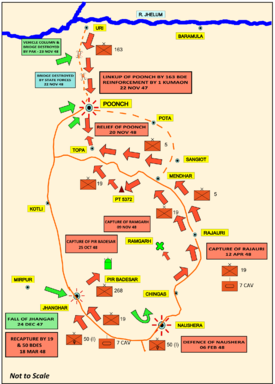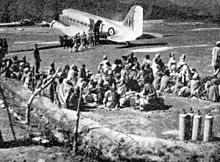- Military operations in Poonch (1948)
-
Military operations took place in Poonch district, then part of the princely state of Jammu and Kashmir, in 1948 during the conflict in Jammu and Kashmir between the Indian Army and Pakistani forces. Poonch withstood a siege by the Pakistanis from November 1947 till relieved by an Indian offensive, Operation Easy on 20 November 1948. The besieged garrison, commanded by Brig Pritam Singh, was maintained by air supply. Military operations ended with Poonch town and the eastern part of Poonch district in Indian hands and western Poonch in Pakistani hands.
Contents
Threat to Poonch
Poonch is a small town in Western Jammu, on the confluence of Batar and Suran rivers, which forms the Poonch river. In 1947, it was the seat of the Raja who was a vassal of Maharaja Hari Singh of Jammu and Kashmir.[1]:89 Prior to 1947, communications with Poonch were through the Punjabi town of Jhelum; towns in the east such as Rajauri, Naushera[2] and Jammu being connected only by fair-weather tracks.
Pakistan had targeted Poonch district, which had a large population of Muslim serving and retired soldiers, as an important objective. Pakistani forces comprised regular soldiers, ex-servicemen and Pashtun tribals, along with Muslim Poonchies inflamed by reports of massacre of Muslim refugees during the communal violence of partition.[3]:18
The attackers infiltrated Poonch, as part of Operation "Gulmarg", as a springboard to capture the Jammu region. The town was threatened by the raiders when JAKFORCE HQ decided to reinforce it from the North.
The relief of Poonch from Jammu was exacerbated by the fact that it lay across many kilometers of hilly terrain with poor communications. Paucity of troops, the need to secure the line of communication and to establish a firm base, and, Prime Minister Nehru's decision to make the Kashmir Valley the immediate priority led to its relief much after the fall of Mirpur, Kotli and Bhimber, towns with predominantly Hindu populations which were swelled by large numbers of non-Muslim refugees. The massacre of the populations of the surrounding areas, not only swelled the refugee population in Poonch, but also led to Pandit Nehru's insisting that it be held, albeit as a besieged outpost, on political grounds over-ruling military advice to vacate it being untenable with the resources at hand.[citation needed]
Reinforcement of Poonch
A total of 40,000 refugees sheltered in Poonch fleeing from tribal atrocities in the West.[1]:91 Since the state forces were grossly inadequate to fend off the raiders, a decision to reinforce the garrison was made by Maj Gen Kalwant Singh, commander of JAKFORCE. An attempt by 50 Parachute Brigade, under Brig Y.S. Paranjpye, was planned. The brigade faced difficult terrain and tough opposition and was not able to relieve Poonch.[4]:124 161st Infantry Brigade, which had pushed the raiders back to Domel on the Muzzafarabad-Srinagar route, was tasked to link up with Poonch from the North.
Just before Poonch was contacted by the raiders, the town was reinforced on 22 Nov 47 by a column from 161 Brigade which left behind an infantry battalion, 1st Battalion (Parachute), Kumaon Regiment (1 KUMAON) under Lieutenant Colonel (later Brigadier) Pritam Singh who became the commander of Poonch garrison. There was also an understrength brigade of J&K State Forces under Brig Kishen Singh already present in Poonch which came under command of the Indian Army.[4]:124
In January 1948, another battalion of infantry, the 3rd Battalion, 9 Gorkha Rifles (3/9 GR) was airlifted into Poonch to bolster the defences.[1]:91
Siege of Poonch
Poonch was isolated by the raiders soon after the reinforcement. Brig Pritam Singh organised the defenses with regular troops, stiffening them with the State Forces and two ad hoc militia battalions, organised from the refugees. The defenders kept the besiegers at bay by vigorous patrolling and fierce small unit actions. An air strip suitable for Dakotas was fashioned using the besieged civilians as labour.
On 12 December 1947, Wing Commander "Baba" Mehar Singh, accompanied by Air Vice Marshal Subroto Mukerjee, carried out a daring trial in a Harvard on the makeshift airstrip. The same day, the first Dakotas landed on Poonch airstrip carrying with them a complete section of mountain artillery. Thereafter the fledgling Royal Indian Air Force began what they called the "Punching" drive, an air bridge of Dakotas, first by day and later by night.[5][6]:304-05[7] The air bridge flew in supplies and flew out refugees, despite interdiction by Pakistani mountain artillery, to counter which Indian 25 pounder guns were flown in.[1]:92-93
The air force also attacked the Pakistani columns with Tempests and Harvards.[5] Attacks on Poonch reduced during summer due to the protracted operations in the Uri sector and were resumed in August 1948, necessitating an immediate relief of Poonch.[1]:93-94
Poonch was referred to as the "Tobruk of Kashmir", though unlike Tobruk, it never fell.[1]:90
Operation Easy
A relieving force under Brig Yadunath Singh was assembled at Rajauri, which eventually grew to be division-sized, comprising 5 and 19 Infantry Brigade as well as "Rajauri column" with supporting field artillery and two troops of Sherman tanks of the Central India Horse.[1]:99-100 The codename of the operation was "Operation EASY" to make the complex operation appear psychologically easier to execute.[1]:95
The operation commenced on the night of 6/7 November with 5 Brigade advancing on the right of the axis of advance and 19 Brigade on the left flank. Bhimber Gali, captured by the two brigades, and Ramgarh fort, captured by Rajauri Force, were the first features to be captured.[1]:100 In the meantime, 268 Infantry Brigade carried out OP RANJIT in which it captured Pir Badesar, a tactically strong locality overlooking the Seri valley which protected Jhangar from the north and posed a direct threat to Kotli and thus protected the flank of the advance from a Pakistani threat to the line of communication near Chingas.[1]:97[3]:257-262
19 Infantry Brigade came across determined opposition at Point 5372, a feature southeast of Mendhar, which guarded the route to Kotli. Continuing to demonstrate against Point 5372 as a ruse, the major force was switched to the right flank where opposition was light. These two brigades then captured Pt 5982 and Topa ridge south of Poonch. On 20 November, the Poonch garrison broke through to the south over the hills for the linkup. On 23 November, Mendhar was a captured in a pincer move by 19 Infantry Brigade from the South permitting the Engineers to construct a jeep track via Mendhar to Poonch.[1]:101-102
Operation Easy resulted in capture of 800 square miles (2,100 km2) of territory. Large numbers of refugees, including 10,000 Muslims were able to get away and obtain relief from the state administration.[1]:102
Aftermath
While Poonch was secured, costly gains made by the Indian 161st Infantry Brigade and 77th Parachute Brigade in the Uri sector were lost by ill-advised vacation of Led Gali and Pir Kanthi picquets in the Haji Pir region for the winter by the Indian brigade commander responsible, allowing Pakistan to reoccupy these picquets and occupy a large salient centred on the Haji Pir pass. Before any action could be taken by the Indians to reduce the salient, ceasefire was declared on 02 Jan 1949 leaving these locations secure in Pakistani hands.[4]:289-291 Poonch continues to be a border outpost on the Line of Control in between the Indian and Pakistani occupied regions of Jammu and Kashmir.
The decision to hold and relieve Poonch saved thousands of civilian lives but at the military cost of diverting troops from the capture of Domel and Muzzafarabad during a period of vulnerability [4] as well as diverting troops from the capture of Mirpur and Bhimber, a more meaningful strategical gambit.[citation needed]
References
- ^ a b c d e f g h i j k l Sinha, Lt. Gen. S.K. (1977). Operation Rescue:Military Operations in Jammu & Kashmir 1947-49. New Delhi: Vision Books. pp. 174. ISBN 81-7094-012-5. http://books.google.co.in/books?id=SMwBAAAAMAAJ. Retrieved 4 August 2010.
- ^ Naushera is a hamlet near Rajauri in Jammu region. It should not be confused with Nowshera, a district and cantonment town in the North West Frontier Province of Pakistan, or Naushera, a village in Khushab district of Pakistan.
- ^ a b Prasad, S.N.; Dharm Pal (1987). History of Operations In Jammu and Kashmir 1947-1948. New Delhi: History Department, Ministry of Defence, Government of India. (printed at Thomson Press (India) Limited). pp. 418..
- ^ a b c d Sen, Maj Gen L. P. (1969). Slender Was the Thread: Kashmir Confrontation 1947-48. New Delhi: Orient Longman. pp. 308. ISBN 0861316924. http://books.google.co.in/books?id=lYHXmx4cOUsC. Retrieved 4 August 2010.
- ^ a b Verma, Kunal. "Operation Poonching". Vayu Aerospace 2000. Bharat Rakshak. http://www.bharat-rakshak.com/IAF/History/1948War/Poonch.html. Retrieved 10 September 2010.
- ^ Longer, V. (1974). Red coats to olive green:A history of the Indian Army, 1600-1974. Bombay: Allied Publishers. pp. 543. ISBN 856551309.
- ^ Longer (1974) mentions that the aircraft was a Beechcraft while the Bharat Rakshak article, of Air Force origin and post-2000 vintage, mentions "Harvard", an aircraft known to have been used extensively in the 1947 Indo-Pakistani operation in the Jammu sector.
External links
- Brig Pritam Singh,MC, Saviour of Poonch. On Govt of India website on Poonch, Jammu & Kashmir. Accessed 24 August 2010.
Categories:- History of Jammu and Kashmir
- 1948 in India
- Indo-Pakistani War of 1947
- Military operations involving India
Wikimedia Foundation. 2010.


